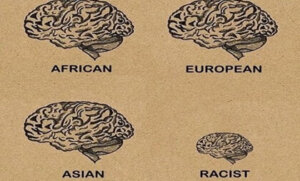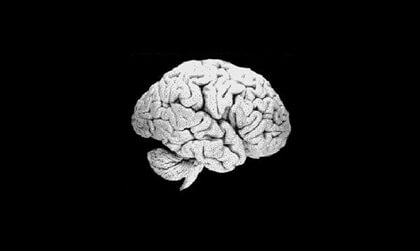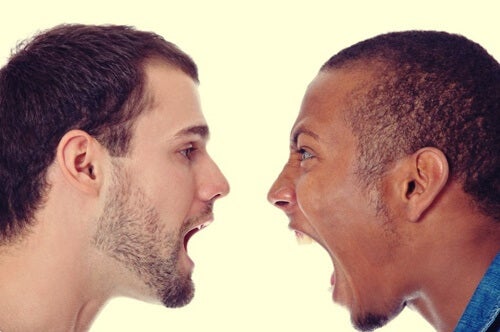How Does the Brain of a Racist Work?


Written and verified by the psychologist Valeria Sabater
The brain of a racist is governed by unfounded prejudice. Also, by the feeling of threat before the unknown, of anything someone perceives as different. Now, beyond what you may think, many people let themselves get carried away by their unconscious racial bias. Thus, any given situation can trigger a discriminatory reaction on those who least expect it.
Experts in racial psychology, Drs. Leslie Zebrowitz and Yi Zhang, from Brandeis University in Massachusetts, point out something rather striking. According to their observations, a significant part of the population has several of these biases. It also presents unconscious but automatic schemes. The same ones that can lead them to think or act in a racist way at any given time.
This is rather worrying. Likewise, there’s another astonishing aspect. Nowadays, neuroscience already offers the tools to understand and even identify the brain of a racist. So much so that, as an article in The Guardian revealed, Americans have already developed a technique based on a brain scanner. It can detect activity in those areas of the brain linked to racial prejudice.
As striking as it may seem, some neural pathways create the imprint of racism. They’re mechanisms built on a very specific primal emotion: fear. Continue reading to analyze the data about it.
“The ultimate measure of a man is not where he stands in moments of comfort and convenience, but where he stands at times of challenge and controversy.”
-Martin Luther King-

Anatomy of the brain of a racist
Professor Jennifer Richeson, a neuroscientist at Dartmouth College in New Hampshire, conducted a striking study. Nature magazine published it in 2003. According to this work, it’s possible to identify the brain of a racist person by observing which areas activate according to specific stimuli presented to them. Or rather, according to their conversations and whom they have them with.
Thus, one thing they observed when interviewing “white” American police officers was that some of them made great efforts to be convincing. Having to concentrate to say nothing offensive or derogatory activated certain brain areas. Similarly, those with a clear racial bias also showed greater activity in certain regions.
The amygdala
This is a small brain structure that’s rather transcendent for human emotions. Thanks to it, people establish the memories linked to emotional aspects. It’s, in turn, the sentinel of fear. One of its main responsibilities is to interpret what can be a threat to then awaken the feeling of rejection, discomfort, or alarm.
Researchers observed how the brain of a racist instantly activates this area when they see people of different ethnicities.

The prefrontal cortex
From a neuroscientific standpoint, people who lack racist biases show a clear difference from those who do. That difference lies in the prefrontal cortex.
- When the amygdala activates by seeing something different (a person of another ethnicity, for example) it instantly connects to the prefrontal cortex, which has a regulatory function.
- Similarly, when the “fear system” activates, the prefrontal areas begin to analyze the situation. Their goal is to think rationally, analyze the situation, and deter or calm that automatic system of fear and rejection.
- Cognitive control by the prefrontal cortex is key to detracting from prejudice. Something that doesn’t occur in the brain of a racist.
The ventral striatum
This is one of the most interesting racial bias related areas. It pertains to that process through which humans opt for social conformity. In other words, people tend to adhere to what the group majority says, to what their family, friends, or part of the population defends. This is because it activates the reward system.
It doesn’t matter that your ideas might be clearly biased. Doing, saying, and thinking like the majority generates complacency. This is because of the ventral striatum that rewards you by releasing dopamine and serotonin. This mechanism, in reality, is a very primitive instinct that allowed groups to stay together in the past and distrust other individuals outside their social unit.
Can the brain of a racist reduce their bias and think otherwise?
At the beginning of the article, there was a citation by Leslie Zebrowitz and Yi Zhang from Brandeis University, Investor Award winners. In 2012, they conducted a study that revealed two things:
- The first observation is that a racist’s brain processes its reality in a different way than one that isn’t racist.
- The second observation is that there’s a way to change it taking into account the high plasticity of the brain. The key is in the approach reflection. That is, it would suffice to continuously expose the racist to those people they reject so that their bias weakens. All so they can assess their prejudices. When someone reflects on their avoidance, fear, and rejection, these things lose strength.
Hence the importance of the educational models based on cooperation that psychologist Elliott Aronson defended back in his day. Tackling these realities early on would certainly help the world create fairer and more respectful societies.
All cited sources were thoroughly reviewed by our team to ensure their quality, reliability, currency, and validity. The bibliography of this article was considered reliable and of academic or scientific accuracy.
- Richerson, Jennifer (2003) An fMRI investigation of the impact of interracial contact on executive function Nature Neuroscience DOI: 10.1038 / nn1156
- Lieberman MD, Hariri A, Jarcho JM, Eisenberger NI, Bookheimer SY: An fMRI investigation of race-related amygdala activity in African-American and Caucasian-American individuals. Nat Neurosci 2005;8:720-722
- Yu R, Mobbs D, Seymour B, Calder AJ: Insula and striatum mediate the default bias. J Neurosci 2010;30:14702-14707.
- Klucharev V, Hytonen K, Rijpkema M, Smidts A, Fernandez G: Reinforcement learning signal predicts social conformity. Neuron 2009;15:140-151
This text is provided for informational purposes only and does not replace consultation with a professional. If in doubt, consult your specialist.








